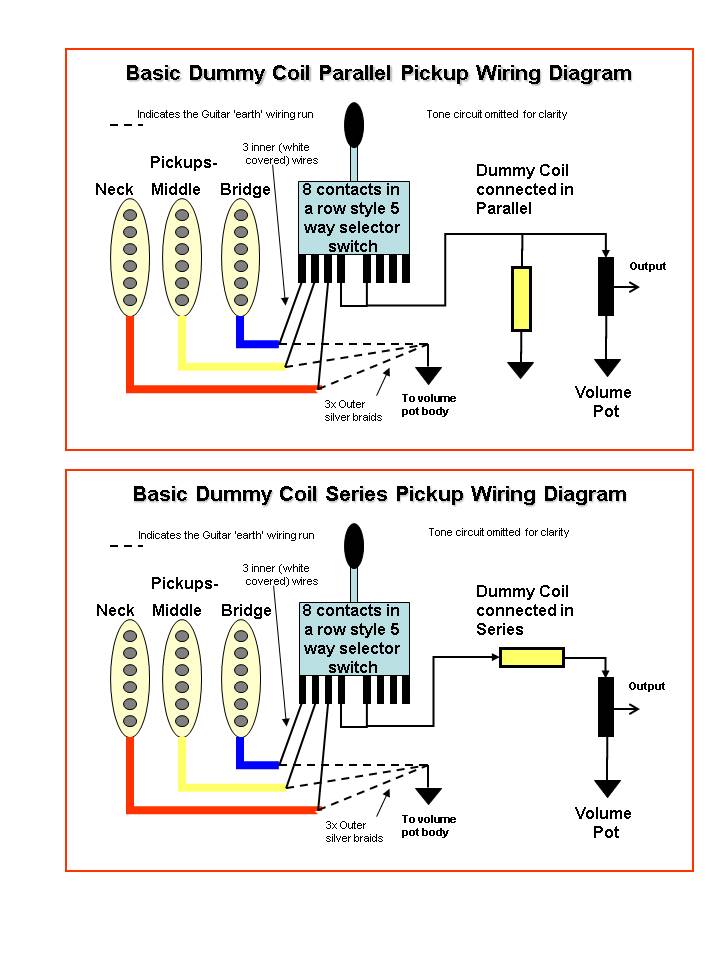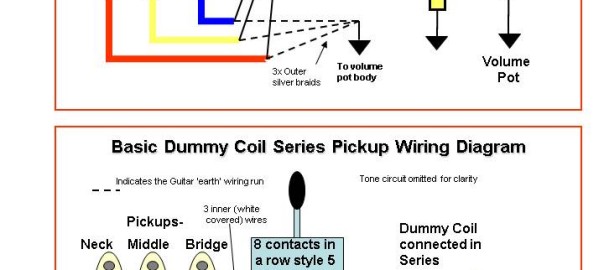Single Coil Pickup Dummy Coil:
Any single coil pickup does just that. It uses a single (rather than multiple) multi-turn (e.g. 8000) coil of wire to sense the movement of metal (i.e. guitar strings) in its vicinity. That's great and gives the single coil characteristic tone we all know and love. But sadly, the same physical construction also does a pretty good job of picking up a range of definitely unwanted electrical noise that the pickup interprets as signal. Sadly us humans detect that as noise not signal! A single coil pickup dummy coil may just be the answer.
Types of electrical noise.
First off its worth spending a moment making a sub division here. Not all guitar noise is the same.
To keep things simple, unwanted guitar noise can be split into 2 categories; hum and buzz are pretty commonly used terms.
Hum is linked to magnetic fields created by mains power circuitry. As such, its dominated by the frequency of the mains electrical system (50Hz here in the UK, 60Hz in N. America for example).
Buzz is much more varied in its source, but can be categorised as a 'transmitted' source and sounds more like static. So in the basket of buzz sources, you find everything from fluorescent lights, electrical power tools and anything with higher frequency electrical switching going on.
Single Coil noise reduction basics.
So lets dig into the basic single coil pickup design a little more. As mentioned its simply a large number of fine wire windings wound around a magnetic arrangement, either as pole pieces or a bar. Its the combination of the magnet(s) and the coil that allows a single coil pickup to sense movement of metal close to it. Putting it another way, the coils alone (without magnets) would not sense that movement (or at least at a hugely reduced level). There are quite a few designs that use different construction, but this article sticks to conventional single coils. For more explanation of single coil and humbucker designs, check out the Ironstone page;
Electric Guitar Pickups Explained
Quieting the Single Coil beast!
So there are 2 main strategies for removing noise from a single coil pickup, shielding and cancelling.
Shielding is normally an effective way of minimising Buzz, but it cannot effectively remove Hum. To do that a single coil pickup dummy coil is an effective solution.
For information on shielding see;
Electric Guitar shielding
So coming back to noise cancelling, this simply means adding an electrical signal containing unwanted noise to another signal containing the 'negative' or 'inverse' of that same noise. The theoretical outcome is that the positive and negative electrical representations of the same noise cancel each other out leaving just the pure (wanted) signal from the vibrating guitar strings. This cancelling (or 'bucking') of the hum is the principle of the humbucker design. That's simply 2 single coils, mounted as close together as possible and each one wound and magnetically aligned opposite to the other. That 'opposite' arrangement is what generates the positive and negative versions of any common noise the humbucker pair is sensitive too. So the humbucker is a very elegant hum cancelling solution, but the tonal characteristic is of course very different to that of a single coil.
Just to complete the picture, a move to active pickups is a way of eradicating both Hum and Buzz. The same is true of 'Noiseless' pickups (effectively humbucker variants), but neither convincingly recreate that single coil tone.
Enter the dummy coil.
So if you want your single pickup to keeps its tonal characteristic, where next?
Well that is where the dummy coil approach comes in. In simple terms, a dummy coil can simply be a single coil with its magnet component removed, and of a similar resistance to the normal coil(s) needing noise cancelling. This dummy coil can either be an 'air-core' (i.e. alnico rod poles removed) or with non magnetic rods still in place. The key requirement is that the dummy coil has its windings and / or its physical up / down orientation arranged to be in opposition to the live coil(s).
There are 2 options for connecting the dummy coil (see diagrams below), either in parallel or series with the live coil(s). The parallel connection is similar to the standard Strat positions 2 and 4 (except using a non-magnetic dummy), and the series connection is similar to a humbucker configuration (but again with a non-magnet dummy). The dummy coil is shown in yellow in the diagrams and any tone controls are omitted for clarity.
The same principles apply for a one, 2 or 3 pickup system. In terms of the connection polarity, its a 50% chance of being right first time!. But what is important to know, is that mounting the dummy coil upside down is the same as changing the polarity of its connection. The difference in background noise will be your guide to which polarity works in your guitar.

So what does a single coil pickup dummy coil sound like? Well either connection style will give a similar result. Either way you will notice a reduction in overall output volume. A Strat set to 10 on the volume knob will sound more it has been turned to 8-9 for example. This is not surprising as the dummy coil is effectively subtracting from the live coils signal.
More importantly, a huge proportion of the background hum will have gone. The amount that goes depends to a large extent on how close the dummy and live coil resistances are. A dummy coil of around 80% of the live coils value gives an excellent noise cancellation whilst leaving some 'life' in the signal which is so critical to single coil tone.
The usual complaint / comment about dummy coils is that the resulting tone has a drop in treble. It's a subjective view of course, and the associated drop in volume can add to that impression. But try an A / B switched version of a dummy coil on a Strat, once the volume is equalised out, and you realise that there is really little tonal difference with the dummy engaged, except of course the welcome reduction in background noise.
For me, the series configuration is tonally better than the parallel route, and does not provide the direct route to ground for treble that the parallel configuration has. But I suspect its a very personal decision.
When you realise players like SRV have used dummy coils as part of their set-ups, it must be worth considering.
The RWRP dilemma;
So far so good, assuming what ever pickup(s) you are trying to noise cancel have the same winding polarity / direction. In those cases, the dummy coil only needs to be the opposite winding (or mounted upside down in relation to the live coils). But what if (as in most modern Strat 3 pickup sets), one coil is reverse polarity relative to the others? Clearly to get the same cancelling effect with all of the pickups, you need some clever switching and possibly more than one dummy to get the inverse polarity through all of the pickup normal combinations. There is actually a wiring method for a RWRP Strat pickup set using a standard 5 way switch and one dummy coils that automatically connects the dummy the right way round in all switch positions (and 'out of circuit' for the position 2 and 4 tones). this needs some very creative thinking and a very good understanding of how the 5 way switch works. See my earlier blog;
Stratocaster 5 Way Switch Tricks
So to finish off, there are another couple of very noteworthy ideas along the same theme. They basically still use a dummy coil, but instead of a 'magnet-less' pickup, the noise cancelling coil is incorporated into a guitar (e.g. Strat) backplate or under the scratchplate itself. Some neat user adjustable mini potentiometers allow fine tuning to match your pickups.
Check out the Ilitch systems at;
ilitchelectronics hum cancelling system



another great read Tony, keep them coming!
Will do Chris! I have been playing with dummy coils on a Jazz Bass too, renowned for their hum pickup. I have got a circuit that will add a single coil to a normal Jazz Bass twin blend pot set-up that’s quite cool. Tony